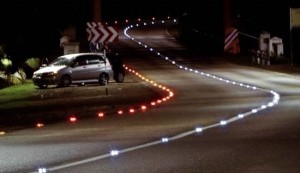Green and sustainable roads

SOLAR-POWERED LED lights similar to these could be embedded along dangerous curves or critical portions of the roads. photo: www.lunaroad.com
Two-thirds of all mega cities are found in Asia. Mega cities are those with over 10 million inhabitants and are fast growing. It follows then that half of air travel today is in Asia.
A major component of mega cities is the urban network made up of roads and highways that link up the various areas within the city.
This urban network must be designed and constructed not only to keep the traffic flowing efficiently but also to maintain road traffic safety to reduce deaths, injuries and property damage from collisions.
Poor interconnectivity
Another concern of the urban network is interconnectivity of the transportation system. With poor interconnectivity it is so inconvenient transferring from one transport system to another whether by train, MRT/LRT, bus, jeepney, or tricycle.
Article continues after this advertisementSadly such is the case in Metro Manila. The inefficient transport system compounds the problem of long lines, overcrowding and disorder in transport stations.
Article continues after this advertisementThis inefficiency gives the wrong impression that there are too many people in the country. In reality, Manila contains 12 percent of total population crowding in less than one percent of our total land area.
Even without contraceptive legislation, the average Filipino woman had 7 children in 1960, 5 in 1980, 3.5 in 2000 and 3 in 2010. Our population will go below zero growth after 2025 at this rate, even without the RH Bill. This is due to lifestyle changes as women marry later and pursue lifelong careers.
We could catch up and even surpass our developed neighboring countries, if only we could put more money into infrastructure development and education, instead of one-third of government expense going into corruption.
Costly accidents
Many of us do not realize the huge economic and social costs due to the number of Filipinos killed or injured in road accidents.
Thirty-six percent of our total population is below 15 years old. They are the most vulnerable to road accidents. Pedestrians and then motorcyclists are the road users most at risk. And to think that motorcycles increase by 40 percent yearly. The cost to society of traffic accidents is reported to be about one percent of GDP (gross domestic product).
The grid-like and traditional road network of old Manila is safer than branching out networks of roads. This gives motorists more routes to choose from.
More connected street networks and more intersections tend to reduce travel speed. It is reported that reducing vehicle speed by 5 percent reduces the number of injuries by 10 percent and the number of fatalities by 20 percent.
Careful design and construction of roads ensure road traffic safety.
Road safety strategies
As the typhoon season continues, we could rely more on the government and private sectors collaboration for road improvement, traffic engineering and road signs. There is money from 7.5 percent of motor vehicles registration collection that goes to the Special Road Safety Fund.
LED lights could be embedded along dangerous curves or critical portions of the roads as in Brunei.
LED lights on pavements could also be installed on pedestrian walks beside lanes for crossing as seen in Wels, Austria.
Tokyo’s Ginza area has trees along sidewalks not only protected with steel gratings but also with LED lights around the base of trees for pedestrians’ and vehicles’ protection. They also beautify the streetscape at night.
In Taipei, to solve the perennial problem of careless drivers who fail to dim their lights along the highways, the government installed pipes about 4 feet high and spaced about 2 or 3 meters apart. From a distance the pipes create an opaque light barrier between the vehicles traveling in opposite directions.
In some US cities, road markers include cat’s eyes and Botts dots that do not fade like paint. Aside from saving on energy use, bright reflectors on road sides will help cut down the number of road accidents in poorly lighted areas and during stormy weather.
For comments or inquiries, e-mail [email protected].